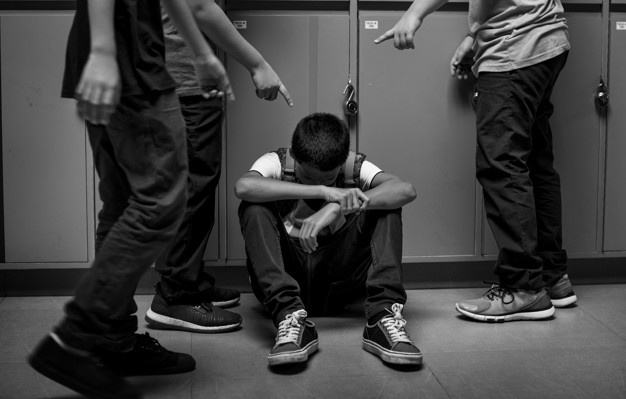Pink Shirt Day: Battling bullying

A third of all school children between 12 and 18 years of age reported having been bullied at school, as per the report from National Center for Education Statistics, 2007
Twelve-year-old Radha was often patronised by her seniors in the convent school for being a quota student and also manhandled by them. Her worst nightmare turned real when she was cornered in the school bathroom and bullied for being poor and unhygienic. She and her family were called names; and to top it all, she was forced to lick her seniors’ shoes. A few days later, Radha committed suicide.
Ten-year-old Imtiaz, a dyslexic, was constantly mocked and mimicked by his classmates. After bearing it for a few months, Imtiaz’s parents filed a complaint against them. However, instead of acting on the complaint, the school authorities rusticated Imtiaz from the school as he did not ‘fit in’. Since then Imtiaz has been now home-schooled.
Thirteen-year-old Mohit was cornered and sexually abused by a group of his classmates in the washroom of the school. He was teased for being thin and weak, and because he was ‘feminine.’ Even though he complained against the bullies, the incident impacted him so much that he stopped talking to family, friends, became indifferent to everything and his school grades dropped significantly. Mohit was then diagnosed with a Type-A cluster personality disorder.
All three cases occurred within a month and were reported by leading dailies. However, bullying is far more prevalent and more often than not it goes unreported because the child or the parents do not file a complaint or that the newspapers do not find them newsworthy.
Even though bullying has existed for perhaps as long as schools have, monitoring and acting against bullying is very recent. The first such report is believed to have been prepared by the United States-based National Center for Education Statistics (NCES) in 2007. The report surprised Americans when it said that overall about a third of all school children between 12 and 18 years of age reported having been bullied at school.
Why ‘Pink Shirt’?
The NCES study as well as other similar reports across the world were the outcome of an incident in Canada when David Shepherd and Travis Price, two high school students, took a stand against homophobic bullying after a new 10-year-old student was harassed and threatened for wearing pink-coloured attire. The two bought and distributed 50 pink shirts and gradually all the students in the school started wearing pink once a week, in solidarity with the victim.
Since then, the last Wednesday of February has been celebrated as ‘Pink Shirt Day or ‘Anti-Bullying Day’.
Status of bullying in India
According to a UNESCO report published in January 2019, titled Behind the numbers: Ending school violence and bullying, one in every three students, globally, has been bullied by their peers in school, and a similar proportion is affected by physical violence. Sadly, in India, these numbers have escalated over the past couple of years.
A more recent study of bullying in India, UNESCO New Delhi’s research titled, Be a Buddy, Not a Bully: experiences of sexual and gender minority youth in Tamil Nadu schools, published in October 2020, highlights different forms of bullying varying according to grade levels – primary, middle/high school or higher secondary. Physical bullying was reported high among middle/high school (60 pc) and higher secondary (50 pc) students while sexual bullying was reported high when the participants were primary school students (43 pc).
“School bullying has become a menace in India and many cases have been identified and reported, recall the incident where a Sikh child was bullied because of his turban, or a Kolkata boy who was locked up in the washroom, or the case of a video made in an eminent Delhi school,” says Kamna Yadav, a Delhi-based clinical psychologist.
Yadav also points out that the pandemic suddenly exposed children to the internet as a necessity, which, also led to increased cases of cyberbullying in India.
Yadav’s statements are backed by reports from education departments in India. Post Covid-19 lockdown, these departments made efforts to ensure continuity of learning through various digital platforms, which has amplified the risk of cyberbullying. To address this, the National Council of Educational Research and Training (NCERT) and UNESCO New Delhi published an information booklet titled Safe online learning in the times of COVID-19, to raise awareness on staying safe online.
Abhinav Tripathi, a transgender activist and a bullying survivor, says “If you consider behavioural characteristics of bullying, you will notice that many parents and teachers resort to ‘bullying’ children. For instance, if a teacher shames a student for walking in a certain way, or for speaking in a ‘feminine’ voice, this then gives license to other children in the class to humiliate this student.”
The aftermath of bullying
“Unfortunately the outcome of bullying isn’t temporary and its effect can be throughout the victim’s life. The long-lasting psychological impact of bullying stems directly from short-term impacts that children experience as the result of being consistently bullied,” says Tripathi.
Psychologists and mental health experts say that bullying has a significant negative effect on children’s mental health, quality of life and academic achievement. “Children who are frequently bullied are nearly three times more likely to feel like an outsider at school and more than twice as likely to miss school when compared to those who are not frequently bullied,” says Archana Kapoor, a Delhi-based school counsellor.
UNESCO, in both its studies on bullying, states that bullying is the most common form of school violence which requires urgent attention. It not only violates a child’s right to education but also impacts their health and well-being and academics negatively.
“Due to social stigma, often learners hide instances of bullying by their teachers and parents. A failure to provide timely support to students can lead to lack of concentration, falling grades, disruptive behaviours, absenteeism or dropping out-of-school completely,” Kapoor adds.
Fight against bullying
“It is a menace which many children experience and one that needs immediate redressal. It is important for caregivers, guardians, parents, authorities, counsellors and psychologists to notice signs of bullying and act soon,” Kapoor says, “Instead of assuming that the child will deal with it on its own, parents must come forward and offer help.”
Sumit Vohra, a teacher in a private school in Delhi, and a father of two girls, says, “Bullying is sadly not taken very seriously by school authorities in India. As a teacher, I have noticed many so-called ‘rich kids’ bullying children from economically weaker backgrounds.”
He adds that when such incidents are reported by the victims or their parents, schools either ignore them or let the bullies go after a warning. “This greatly affects the psyche of the one who is bullied. Parents and educators need to jointly tackle this menace,” says Vohra.
Experts also say that parents should strengthen their communication with children so that bullying comes up in conversations, especially when children are younger. They should feel comfortable telling about their fears and these conversations can be a part of a broader conversation about respecting other people’s opinions and differences.
“To ensure safe and inclusive learning environments, bullying needs to be addressed swiftly, and the consequences should include recommendation counselling of bullies too. Many bullies, especially children, have often faced problems of their own and talking about them could help them not displace their pain on others,” says activist Tripathi.
He further says that the challenge we now face is committing the time and resource to these interventions and policies in order to put an end to bullying, for which, the first and the most important step is to address it as a ‘problem’ rather than ‘a part and parcel of growing up’.










